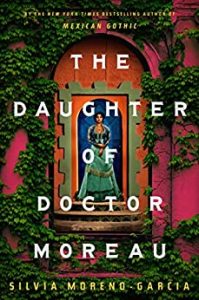Ian Mond Reviews The Daughter of Doctor Moreau by Silvia Moreno-Garcia
 The Daughter of Doctor Moreau, Silvia Moreno-Garcia (Del Rey 978-0-59335-533-6, $28.00, 320pp, hc) July 2022.
The Daughter of Doctor Moreau, Silvia Moreno-Garcia (Del Rey 978-0-59335-533-6, $28.00, 320pp, hc) July 2022.
Silvia Moreno-Garcia’s The Daughter of Doctor Moreau is not a prequel or sequel to H.G. Wells’s classic short novel The Island of Doctor Moreau. It’s a reboot. And like all good reboots, Moreno-Garcia takes the key ingredients – Moreau’s “study of the plasticity of living forms,” his alcoholic assistant Montgomery, an isolated environment, and, most importantly, the “Beast People” – and reimagines them in a notably different manner but in keeping with the source material. The inclination would be to update the story for the 21st century, to reframe the Doctor as a fringe scientist illegally experimenting with animal and human DNA. Thankfully, Moreno-Garcia goes in a different direction, one that aligns with her undertaking to infuse traditional genre tropes – whether it be vampires, the Gothic, or Regency romances – with Mexican culture and history.
Instead of an unnamed island somewhere between Peru and Chile, Moreno-Garcia situates The Daughter of Doctor Moreau amongst the tropical rainforests and jungles of the Yucatán. The bulk of the action takes place in 1877 during the decades-long “Caste War” between the Maya people and the Mexican Government. Against this backdrop, in a hacienda called Yaxaktun, Doctor Moreau, along with his daughter Carlota, continues his experiments on animal/human hybrids with the capacity to talk, walk upright, and manipulate tools. Yaxaktun is owned by Henry Lizalde, a wealthy businessman who funds Moreau’s work on the promise that the hybrids will eventually replace the rebellious Mayan people who work on Lizalde’s plantations. But for Moreau, the hybrids – of which there are twenty-nine living on the hacienda – are much more than a potential workforce. They are the next step in human evolution.
The narrative alternates between the third-person viewpoint of Carlota and the major-domo of Yaxaktun, Montgomery Laughton (the surname a lovely reference to Charles Laughton, who played Doctor Moreau in the first English-language movie adaptation of Wells’s novel, The Island of Lost Souls). Like his doppelgänger in The Island of Doctor Moreau, Montgomery is a high-functioning alcoholic able to perform his daily duties around the hacienda and, every few months, hunt jaguars (not pumas) for the Doctor’s experiments. But unlike Wells’s Montgomery, about whom we know very little (aside from him leaving London having made a “young ass” of himself), Moreno-Garcia provides insight into Laughton’s past, which includes an abusive childhood, a sister who committed suicide, and a failed marriage. Regarding Carlota, we’re told by Moreau that she was born with a rare condition of the blood, an ailment he cured by fashioning a medication that combines “certain unique elements found in the jaguar with the essential gemmules of my child.” Now 20 years of age, Carlota is a charming, beautiful young woman who has spent most of her life tending to the hybrids, especially her close friends Lupe and Cachito. Everything, however, changes for Carlota and the residents of Yaxaktun with the arrival of Henry’s son, Eduardo Lizalde, a dashing young man with “lively green eyes” who takes an immediate shine to Carlota, an attraction she reciprocates.
Moreno-Garcia’s inspired changes to Wells’s novel don’t end with the setting, the introduction of Carlota, or the fleshing out of both Montgomery and Moreau (who in this reboot is a citizen of France). The lack of vivisection – the Doctor’s experiments, as noted above, involve the commingling of Darwinian gemmules – means there’s no animal torture, with Wells’s “House of Pain” now a clever reference to the room where the hybrids receive their weekly injections. More profoundly, Moreno-Garcia not only removes any mention of “Beast People,” but her hybrids also don’t regress like their Wellsian counterparts; they may be genetically flawed, but they maintain their intelligence and sentience throughout. The one theme of The Island of Doctor Moreau that Moreno-Garcia does lean into is Moreau’s use of religion to discipline his creations. The hybrids are expected to attend weekly services in a makeshift chapel where Moreau piously quotes scripture, setting himself up, in their eyes, as a God-like figure. For both Wells and Moreno-Garcia, this epitomises Moreau’s arrogance, his belief that he stands above nature. But Moreno-Garcia also explores how spirituality and God shape Carlota’s worldview. Even when faced with Montgomery’s atheism, her father’s egotism, and the violent events of the novel, she remains a believer in the God she “glimpsed… in between the orchids and vines of Yaxaktun.” It’s a depiction of faith that’s far more subtle and meaningful than Wells’s satirical approach.
I know I’ve spent the entirety of this review comparing The Daughter of Doctor Moreau to The Island of Doctor Moreau, leaving the impression that you need to have read that book to fully appreciate Moreno-Garcia’s fine novel. But that’s not the case. With its evocative prose, post-colonial historical setting that drives the plot, and the introduction of vibrant, fascinating characters, both familiar and new, The Daughter of Doctor Moreau very much stands on its own.
Ian Mond loves to talk about books. For eight years he co-hosted a book podcast, The Writer and the Critic, with Kirstyn McDermott. Recently he has revived his blog, The Hysterical Hamster, and is again posting mostly vulgar reviews on an eclectic range of literary and genre novels. You can also follow Ian on Twitter (@Mondyboy) or contact him at mondyboy74@gmail.com.
This review and more like it in the July 2022 issue of Locus.
 While you are here, please take a moment to support Locus with a one-time or recurring donation. We rely on reader donations to keep the magazine and site going, and would like to keep the site paywall free, but WE NEED YOUR FINANCIAL SUPPORT to continue quality coverage of the science fiction and fantasy field.
While you are here, please take a moment to support Locus with a one-time or recurring donation. We rely on reader donations to keep the magazine and site going, and would like to keep the site paywall free, but WE NEED YOUR FINANCIAL SUPPORT to continue quality coverage of the science fiction and fantasy field.
©Locus Magazine. Copyrighted material may not be republished without permission of LSFF.







